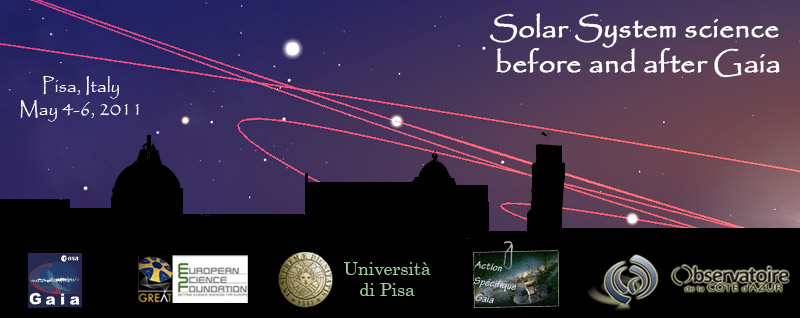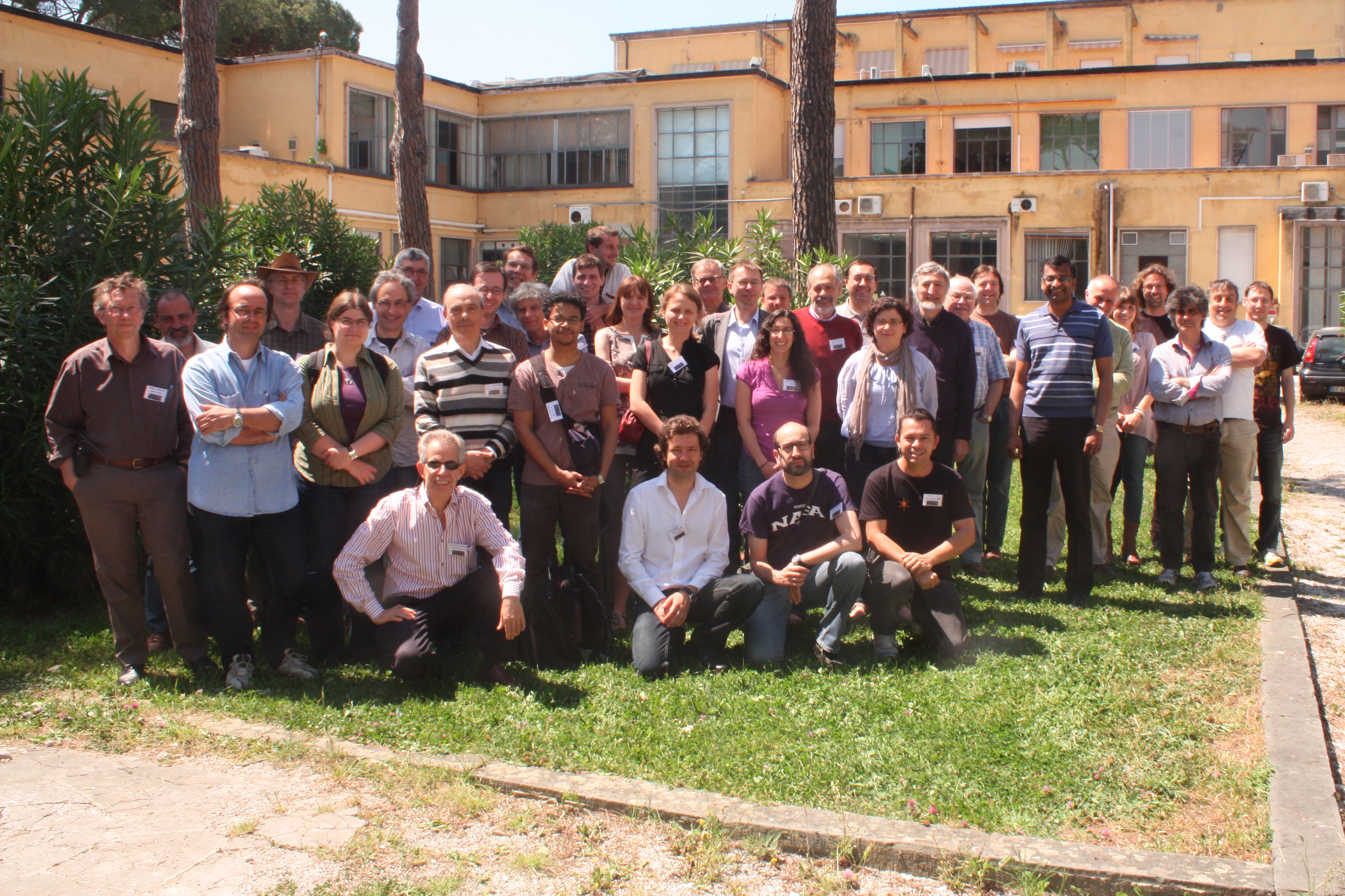

KEY DATES
October 11 : 1st announcement
November 15 : 2nd announcement, registration opens
March 18 : deadline for registration and abstract submission.
April 4 : final announcement to registered participants, preliminary program
May 4-6 : workshop
July 29 : tentative submission deadline proceedings
By performing a systematic survey
of the whole sky down to magnitude V = 20, Gaia will be able to survey through
repeated observations spanning over 5 years several 100,000s asteroids. It will
directly measure sizes of about 1,000 objects, obtain the masses of about 100
of them, derive spin properties and overall shapes of more than 10,000 objects,
yield much improved orbits and taxonomic classification for most of the observed
sources. The final results will also include direct measurements of tiny radiative
effects on small bodies, in particular of
the Yarkovsky effect acting on near-Earth objects, and the measurement of tiny
relativistic effects on the motion of some of these bodies. An impressive improvement
of orbit accuracy for know objects will also become possible (by at least two
order of magnitude). Low activity distant comets and low elongation Earth crossers
could also be discovered.
Given the above expectations, we organize a meeting aimed at informing the scientific community active in asteroid science about the unprecedented opportunities offered by the Gaia mission. The goal of this meeting is twofold: on one hand to spread information and awareness about Gaia; on the other hand, to organize future activities and collaboration, in order to best exploit the observations that Gaia will perform.
LIST OF TOPICS:
- the Gaia mission and its impact on Solar System science;
- opportunities provided by probable intermediate data releases;
- impact on future ground-based observational activities;
- complementary sources of data (other surveys) and joint data exploitation;
- organization of future activities (ESF GREAT programme, other initiatives)
The general organization of the
conference will be as follows:
Wednesday, May 4
9:00 Reception of the participants at the conference site
9:40 Communications from the LOC
9:50 F. Mignard - The Gaia
mission
10:20 P. Tanga - The impact
of Gaia on Solar System science
10:50 A. Dell'Oro - Observations
of asteroids on the Gaia astrometric focal plane
11:10 coffee break
11:30 W. Thuillot - Ground-based
follow up of asteroids observed by Gaia
11:50 D. Bancelin - Near
Earth Asteroid astrometry with Gaia
12:10 M. Todd - An
optimal search strategy for Trojan asteroids and science follow-up of Gaia alerts
with the Zadko telescope, Western Australia
13:00 lunch
14:30 K. Muinonen - Asteroid
orbital inversion using Markov-chain Monte Carlo methods
15:00 D. Hestroffer - Global
effects on asteroid dynamics
15:20 A. Fienga - Use of asteroids
for the improvement of planetary ephemerides
15:40 H. Varvoglis - Constraining
asteroid dynamical models using Gaia data
16:00 coffee break
16:20 B. Carry - Shape models
and densities of asteroids in the post-Gaia era
16:40 F. Colas - Measuring
asteroid densities
17:00-17:30 Discussion: Gaia mission, alerts, asteroid dynamics
Thursday, May 5
9:30 A. Cellino - Asteroid
physical properties from Gaia
10:00 P. Pravec - Near-Earth
and small main-belt binary asteroids, their population and properties
10:30 A. Carbognani - The
representation of asteroid shapes: a test for the inversion of Gaia photometry
10:50 J. Hanus - The potential
of combined sparse photometric data in asteroid shape modelling
11:10 coffee break
11:30 H. Campins - Colors
of asteroid families
12:00 M. Delbo - Asteroid
spectroscopy and unsupervised classification from Gaia data
12:20 J. Gayon-Markt - Mineralogical
classification of asteroids before and after Gaia
12:40 F. DeMeo - Observations
motivated by SDSS colors relevant to Gaia
13:00 lunch
14:50 M. Mueller - Age of asteroid surfaces from Gaia and WISE16:10 coffee break
16:30 K. Muinonen - Gaia Research for European Astronomy Training (GREAT)
16:50 Discussion: physical studies. Organizing future activities in the frame
of GREAT: propositions
Social dinner
Friday, May 6
9:30 M.W. Buie - Occultations
and duplicity constraints on Gaia
10:00 B. Sicardy - Probing
Trans-Neptunian Objects with stellar occultations
10:20 G. Tancredi - The size
distribution of TNOS and the implications for the discovery of large members
and the prediction of occultations
10:40 L. Beauvalet - Constraining
Pluto's system with Gaia
11:00 coffee break
11:20 G.P. Tozzi - Observability
of comets with Gaia
11:40 H. Rickman - Gaia and
the new comets from the Oort cloud
12:00 - 12:45 - final discussion: occultations, comets. Future actions. Meeting
summary.
The conference is based on invited/solicited talks, with limited space for short
contributions. A title and an abstract of the proposed contributions should
be submitted on the web page available for registration.
Meeting place :
University of Pisa, Italy, conference room of the National Nuclear Physics Institute.
Room 9131, Dipartimento di Fisica / INFN, Largo Pontecorvo 3, 56127 Pisa
The town is efficiently connected
to all destinations by its international airport; it is also on a main railway
line. Being a world-wide known town famous for its artistic, historical
and touristic attractions, a wide choice of hotels of all categories is available.
The epoch of the conference does not correspond to high touristic season, nevertheless
it is suggested to make hotel reservations as early as possible.
View Pisa - Gaia meeting in a larger map
How to reach meeting location:
- By car : It is not recommended to come via car. There are many restrictions to the circulation in the town. Moreover the various interesting sites are at walking distances. However, if you arrive by the motorway you should take either "Pisa Nord" or "Pisa Sud" exits, then follow the arrows on the above map to reach the car park closest to the meeting location.
- From the Airport is located 1 km from downtown: Bus and taxi are the best choices for going down town, while trains are rather infrequent. Please note that Pisa airport is in a nearly unique situation, being at 20 min walking distance from the main railway station. Bus line “LAM red”, (see timetable and map), stop at the railway station and then change to bus line 4 or “LAM green”.
- From the railway station: bus line “LAM green” just outside Department of Physics (direction “Stazione FS”) (see timetable and map)
In town, bus is the best choice if
you don't like to walk. Bus tickets can be obtained at an automated vendor machine
at the airport, close to bus stop. In town, they can be bought at many tobacconist
shops and some newspapers kiosks.
Links: public transports in Pisa (CPT).
Accomodations:
Convenient fares have been negotiated
with the "Hotel Cecile", www.hotelcecile.it:
60 Euros for a double room for 1 person. To put a reservation there, please
drop an e-mail to hotelcecile@virgilio.it mentioning "Meeting -
M. Paolicchi".
You can find several other hotels here.
However, keep in mind that May is a busy tourist season in Pisa, so put your
reservation as soon as possible. Several months in advance you can find interesting
reduced fares.
More touristic information at http://www.provincia.pisa.it/
